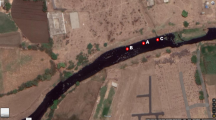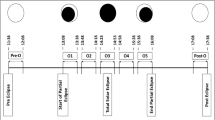Abstract
Severe stresses have deleterious effects, but mild stresses can have beneficial effects called hormetic effects. This study observed survival time of wild-type Drosophila melanogaster flies and dFOXO mutants exposed to 37 °C, a severe stress for flies, after they lived or not for 2 weeks in hypergravity (3 or 5 g), a mild stress with hormetic effects in flies. Hypergravity increased survival time of the mutants, this effect being less observed in wild-type flies. The heat stress increased dFOXO translocation similarly in all gravity groups in a wild-type strain, and hypergravity decreased dFOXO translocation similarly in heat-stressed or not heat-stressed males, no clear effect of the gravity level being observed in females. Because hypergravity increases resistance to heat in dFOXO mutants and the translocation is not tightly dependent on the gravity level, one can conclude that dFOXO does not mediate the effect of hypergravity on resistance to heat. A previous study showed that another mild stress, the cold, can increase survival time at 37 °C of wild-type D. melanogaster flies, but this was not observed in dFOXO mutants. Therefore, two mild stresses, cold and hypergravity, can increase resistance to heat but the pathways mediating this effect are seemingly different, as cold does not increase resistance in dFOXO mutants while hypergravity increases it.


Similar content being viewed by others
References
Donovan MR, Marr MT II (2016) dFOXO activates large and small heat shock protein genes in response to oxidative stress to maintain proteostasis in Drosophila. J Biol Chem 291:19042–19050
Giannakou ME, Goss M, Partridge L (2008) Role of dFOXO in lifespan extension by dietary restriction in Drosophila melanogaster: not required, but its activity modulates the response. Aging Cell 7:187–198
Hazelrigg T, Levis R, Rubin GM (1984) Transformation of white locus DNA in Drosophila: dosage, compensation, zeste interaction, and position effects. Cell 36:469–481
Hercus MJ, Loeschcke V, Rattan SIS (2003) Lifespan extension of Drosophila melanogaster through hormesis by repeated mild heat stress. Biogerontology 4:149–156
Jünger MA, Rintelen F, Stocker H, Wasserman JD, Veégh M, Radimerski T, Greenberg ME, Hafen E (2003) The Drosophila forkhead transcription factor FOXO mediates the reduction in cell number associated with reduced insulin signaling. J Biol 2(3):20
Kristensen TN, Sørensen JG, Loeschcke V (2003) Mild heat stress at a young age in Drosophila melanogaster leads to increased Hsp70 synthesis after stress exposure later in life. J Genet 82:89–94
Le Bourg E (1999) A review of the effects of microgravity and of hypergravity on aging and longevity. Exp Geront 34:319–336
Le Bourg E (2007) Hormetic effects of repeated exposures to cold at young age on longevity, aging and resistance to heat or cold shocks in Drosophila melanogaster. Biogerontology 8:431–444
Le Bourg E (2008) Three mild stresses known to increase longevity in Drosophila melanogaster flies do not increase resistance to oxidative stress. Am J Pharmacol Toxicol 3:137–143
Le Bourg E (2009) Hormesis, aging, and longevity. Biochim Biophys Acta 1790:1030–1039
Le Bourg E (2012) Combined effects of two mild stresses (cold and hypergravity) on longevity, behavioral aging, and resistance to severe stresses in Drosophila melanogaster. Biogerontology 13:313–328
Le Bourg E (2013) Fasting can protect young and middle-aged Drosophila melanogaster flies against a severe cold stress. Biogerontology 14:513–529
Le Bourg E (2015) Fasting and other mild stresses with hormetic effects in Drosophila melanogaster can additively increase resistance to cold. Biogerontology 16:517–527
Le Bourg E (2017) Combining three mild stresses in Drosophila melanogaster flies does not have a more positive effect on resistance to a severe cold stress than combining two mild stresses. Biogerontology 18:275–284
Le Bourg E, Fournier D (2004) Is lifespan extension accompanied by improved antioxidant defences? A study of superoxide dismutase and catalase in Drosophila melanogaster flies that lived in hypergravity at young age. Biogerontology 5:261–266
Le Bourg E, Massou I (2015) Fasting increases survival to cold in FOXO, DIF, autophagy mutants and in other genotypes of Drosophila melanogaster. Biogerontology 16:411–421
Le Bourg E, Minois N (1997) Increased longevity and resistance to heat shock in Drosophila melanogaster flies exposed to hypergravity. C R Acad Sci Paris 320:215–221
Le Bourg E, Minois N, Bullens P, Baret P (2000) A mild stress due to hypergravity exposure at young age increases longevity in Drosophila melanogaster males. Biogerontology 1:145–155
Le Bourg E, Valenti P, Lucchetta P, Payre F (2001) Effects of mild heat shocks at young age on aging and longevity in Drosophila melanogaster. Biogerontology 2:155–164
Le Bourg E, Valenti P, Payre F (2002) Lack of hypergravity-associated longevity extension in Drosophila melanogaster flies overexpressing hsp70. Biogerontology 3:355–364
Le Bourg E, Malod K, Massou I (2012) The NF-κB-like factor DIF could explain some positive effects of a mild stress on longevity, behavioral aging, and resistance to strong stresses in Drosophila melanogaster. Biogerontology 13:455–465
Mattson MP, Calabrese EJ (eds) (2010) Hormesis. A revolution in biology, toxicology and medicine. Springer, Dordrecht
Minois N, Le Bourg E (1999) Resistance to stress as a function of age in Drosophila melanogaster living in hypergravity. Mech Ageing Dev 109:53–64
Minois N, Guinaudy MJ, Payre F, Le Bourg E (1999) HSP70 induction may explain the long-lasting resistance to heat of Drosophila melanogaster having lived in hypergravity. Mech Ageing Dev 109:65–77
Moskalev AA, Plyusnina EN, Shaposhnikov MV (2011) Radiation hormesis and radioadaptive response in Drosophila melanogaster flies with different genetic backgrounds: the role of cellular stress-resistance mechanisms. Biogerontology 12:253–263
Polesello C, Le Bourg E (2017) A mild cold stress that increases resistance to heat lowers FOXO translocation in Drosophila melanogaster. Biogerontology 18:791–801
Puig O, Mattila J (2011) Understanding forkhead box class O function: lessons from Drosophila melanogaster. Antioxid Redox Signal 14:635–647
Rattan SIS, Kyriazis M (eds) (2019) The science of hormesis in health and longevity. Elsevier, Oxford
Rattan SIS, Le Bourg E (eds) (2014) Hormesis in health and disease. CRC Press, Boca Raton
Slack C, Giannakou ME, Foley A, Goss M, Partridge L (2011) dFOXO-independent effects of reduced insulin-like signaling in Drosophila. Aging Cell 10:735–748
Slaidina M, Delanoue R, Gronke S, Partridge L, Léopold P (2009) A Drosophila insulin-like peptide promotes growth during nonfeeding states. Dev Cell 17:874–884
Sørensen JG, Kristensen TN, Kristensen KV, Loeschcke V (2007) Sex specific effects of heat induced hormesis in Hsf-deficient Drosophila melanogaster. Exp Gerontol 42:1123–1129
Acknowledgements
This work was partly supported by a grant from the “Centre de Biologie Intégrative, Université de Toulouse”. The dFOXO21 and dFOXO25 flies were kindly provided by Hugo Stocker and Igor Vuillez (Institute of Molecular Systems Biology, ETH, Zurich, Switzerland) and the dFOXOΔ94 flies by Julien Colombani (Institut of Biology Valrose, University of Nice-Sophia-Antipoplis, Nice, France). The primary anti-Foxo antibody is a kind gift of Pierre Léopold (Institut of Biology Valrose, University of Nice-Sophia- Antipoplis, Nice, France). Thanks are due to the referees for their comments which helped to improve the article.
Author information
Authors and Affiliations
Corresponding author
Additional information
Publisher's Note
Springer Nature remains neutral with regard to jurisdictional claims in published maps and institutional affiliations.
Electronic supplementary material
Below is the link to the electronic supplementary material.
Rights and permissions
About this article
Cite this article
Le Bourg, E., Polesello, C. Hypergravity increases resistance to heat in dFOXO Drosophila melanogaster mutants and can lower FOXO translocation in wild-type males. Biogerontology 20, 883–891 (2019). https://doi.org/10.1007/s10522-019-09836-z
Received:
Accepted:
Published:
Issue Date:
DOI: https://doi.org/10.1007/s10522-019-09836-z




